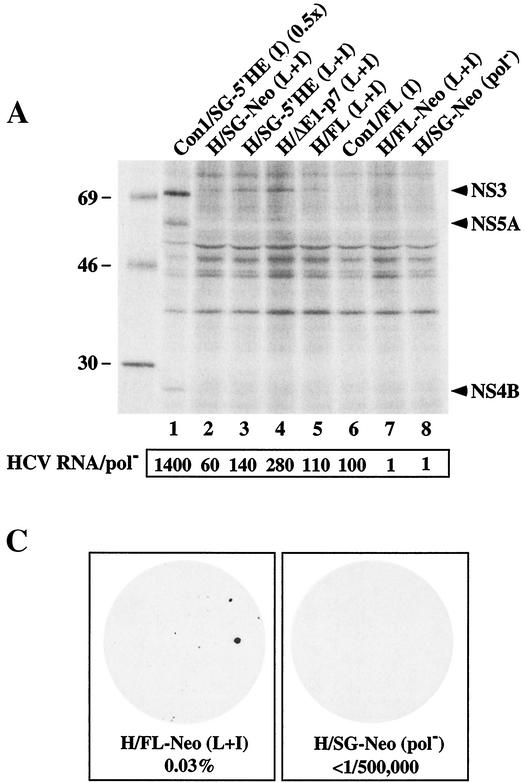FIG. 5.
Replication of HCV RNAs with and without heterologous elements. (A) Huh-7.5 cells were transfected with 1 μg (each) of full-length and subgenomic RNAs, and 2 × 105 cells were plated in 35-mm-diameter wells. Ninety-six hours posttransfection, the Huh-7.5 cells were labeled with [35S]methionine and [35S]cysteine for 10 h. The cells were lysed, and HCV proteins were isolated by immunoprecipitation using a patient serum specific for NS3, NS4B, and NS5A. HCV proteins and the positions of protein molecular-mass standards (in kilodaltons) are shown. In lane 1, half the amount of immunoprecipitated sample was loaded (0.5x). The ratio of HCV RNA relative to the pol− negative control (HCV RNA/pol−) is shown below each lane. (B) Transfected Huh-7.5 cells were fixed with 4% paraformaldehyde and permeabilized with 0.1% saponin, and the frequency of cells expressing NS3 antigen was quantified by FACS. The percentage of cells expressing NS3 relative to pol−-transfected cells and an isotype-matched IgG was determined and is shown in the upper left corner of each plot. The median fluorescence intensity of the gated positive cells is shown in the upper right corner of each plot. FSC-H, forward scatter; FL1-H, fluorescence. (C) One microgram (each) of H/FL-Neo (L+I) and H/SG-Neo (pol−) RNA was electroporated into Huh-7.5 cells, and 2 × 106 cells were plated on 100-mm-diameter dishes. G418 selection was applied 48 h posttransfection, and after 3 weeks in culture, G418-resistant foci were fixed and stained with crystal violet. The G418 transduction efficiency, displayed below each dish, was determined as described in the legend to Fig. 3.


